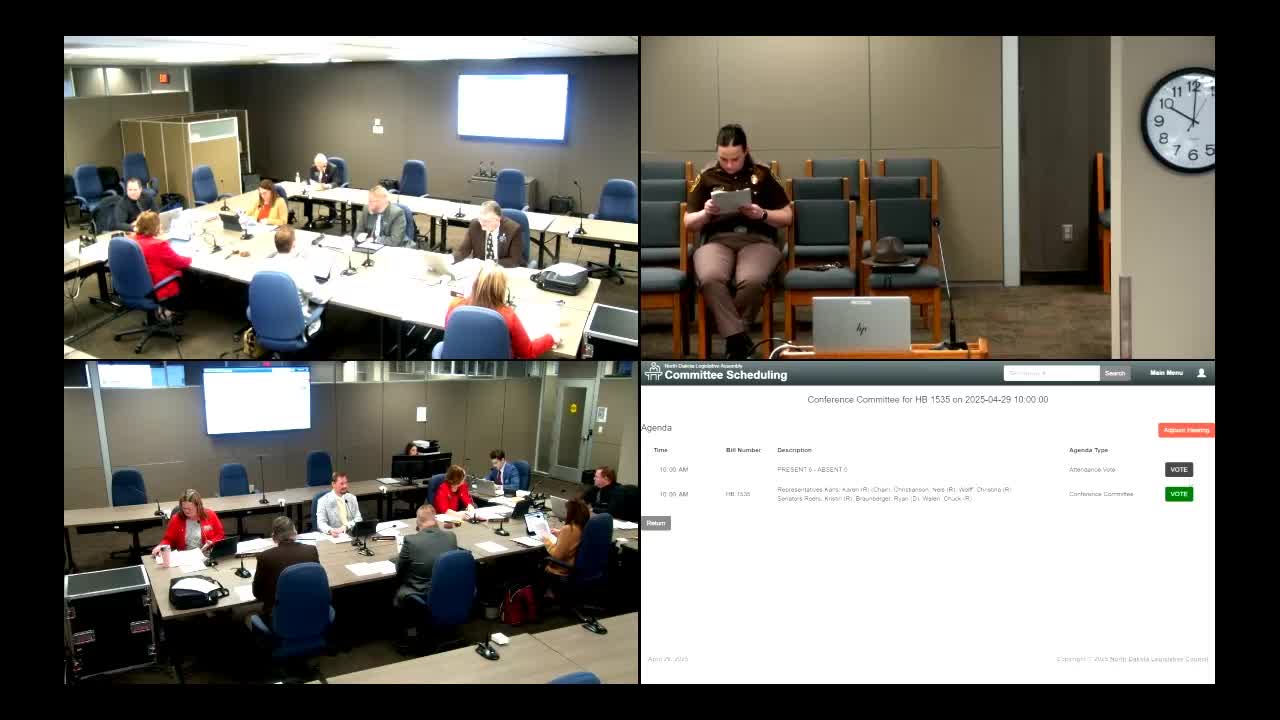North Dakota legislators discuss creation of feather alert notice system for indigenous peoples
April 29, 2025 | House of Representatives, Legislative, North Dakota
This article was created by AI summarizing key points discussed. AI makes mistakes, so for full details and context, please refer to the video of the full meeting. Please report any errors so we can fix them. Report an error »

The HB 1535 Conference Committee convened on April 29, 2025, to discuss significant amendments to North Dakota's alert notification system, particularly focusing on the introduction of a new "feather alert" for missing Indigenous persons. The meeting began with an overview of the bill's purpose, which aims to create a new section in the North Dakota Century Code regarding the feather alert notice system and amend existing legislation related to the Committee on Tribal and State Relations.
Senator Rose presented several versions of the bill, highlighting changes made since it left the House. Notably, the passage of Senate Bill 2098, which included an emergency clause, necessitated updates to the code that were not initially anticipated. The feather alert is defined similarly to the existing missing endangered persons alert but is specifically designated for individuals of Indigenous heritage. This distinction aims to enhance awareness and response for cases involving Indigenous individuals.
The committee discussed the activation process for the alert system, ensuring that relevant stakeholders, including tribal representatives, are involved in the activation of alerts. The bill also emphasizes the inclusion of alerts in Indigenous languages when feasible, while prioritizing the expediency of alert dissemination to avoid delays.
Further discussions included the role of the Indian Affairs Commission as a liaison for the feather alert system, with the Bureau of Criminal Investigation (BCI) and Highway Patrol tasked with providing annual reports on the effectiveness of the alerts. The committee acknowledged the importance of public meetings with tribal representatives to share findings and improve community awareness.
The meeting concluded with a focus on the criteria for activating the feather alert and missing endangered persons alert, ensuring that the operational plan for public notifications remains robust, even if certain alerts do not meet the minimum criteria for wireless emergency alerts.
Overall, the committee's discussions reflect a commitment to improving the alert system in North Dakota, particularly for Indigenous communities, while ensuring that the process remains efficient and effective in responding to emergencies. The next steps will involve further refinement of the bill and continued collaboration with stakeholders to finalize the legislation.
Senator Rose presented several versions of the bill, highlighting changes made since it left the House. Notably, the passage of Senate Bill 2098, which included an emergency clause, necessitated updates to the code that were not initially anticipated. The feather alert is defined similarly to the existing missing endangered persons alert but is specifically designated for individuals of Indigenous heritage. This distinction aims to enhance awareness and response for cases involving Indigenous individuals.
The committee discussed the activation process for the alert system, ensuring that relevant stakeholders, including tribal representatives, are involved in the activation of alerts. The bill also emphasizes the inclusion of alerts in Indigenous languages when feasible, while prioritizing the expediency of alert dissemination to avoid delays.
Further discussions included the role of the Indian Affairs Commission as a liaison for the feather alert system, with the Bureau of Criminal Investigation (BCI) and Highway Patrol tasked with providing annual reports on the effectiveness of the alerts. The committee acknowledged the importance of public meetings with tribal representatives to share findings and improve community awareness.
The meeting concluded with a focus on the criteria for activating the feather alert and missing endangered persons alert, ensuring that the operational plan for public notifications remains robust, even if certain alerts do not meet the minimum criteria for wireless emergency alerts.
Overall, the committee's discussions reflect a commitment to improving the alert system in North Dakota, particularly for Indigenous communities, while ensuring that the process remains efficient and effective in responding to emergencies. The next steps will involve further refinement of the bill and continued collaboration with stakeholders to finalize the legislation.
View full meeting
This article is based on a recent meeting—watch the full video and explore the complete transcript for deeper insights into the discussion.
View full meeting
